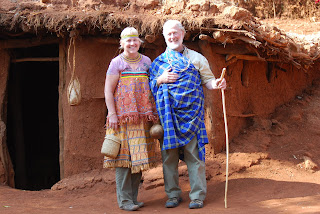
We were the first ones up this morning at Migration Camp. Ephata had big plans for us today.
He's determined to find some of the animals that we have not yet sighted, namely leopards and rhinos.
Our camp is located directly in the path of the animals' migration. In fact, we have been warned not to wander from the camp unescorted because the hippos (most dangerous animal in the wild) are out in force. Last night as we tried to return to our tent for the night, we had to wait out a battle between two recalcitrant hippos near our tent. They kept up their fighting throughout the night!
On our morning dri
 ve, Ephata pointed out the giant "kopjes" or boulders that have been part of the landscape for over 400 million years. Kopjes is a German word that means small heads. Hmmm, they look like giant heads to me.
ve, Ephata pointed out the giant "kopjes" or boulders that have been part of the landscape for over 400 million years. Kopjes is a German word that means small heads. Hmmm, they look like giant heads to me.These huge rock formations were everywhere and felt like monuments commemorating the majestic creatures that they over see. They were also a favorite lounging place for the big cats.
 We have realized that the further north we go in the Serengeti, the more animals we see and the more deciduous forests are evident. This is a mother giraffe with two babies. There is nothing on this planet more adorable tha
We have realized that the further north we go in the Serengeti, the more animals we see and the more deciduous forests are evident. This is a mother giraffe with two babies. There is nothing on this planet more adorable tha n
n 
 a baby giraffe!
a baby giraffe!The Serengeti Plain is a landscape that seemingly has no boundaries. The distant escarpment seems to be hidden behind a scrim of mist and the sky is mildly overcast giving the dry landscape the effect of being a water color painting. This feels like being on another planet because it is like nothing I've ever experienced on the earth.
At several points during this day's exploration, we found ourselves completely eng
 ulfed by herds of hundreds of roaming herbivores.
ulfed by herds of hundreds of roaming herbivores.
A side bar about wildebeests and zebras: They enjoy a symbiotic relationship. It is our understanding that zebras have a very keen sense of sight; they are also very smart. Wildebeests, on the other hand, have poor vision, but a great sense of smell. Wildebeests are also not very smart. The zebras like hanging out with the wildebeests because the silly wildebeest is virtually a decoy. Let's face it, zebras got left out when nature was handing out camouflage!
 Also, zebras stripes are as individual as finger prints!!!! Who knew?
Also, zebras stripes are as individual as finger prints!!!! Who knew?We have settled into the quiet wonderment of simply watching these creatures interact with one another. This is a band of buzzards waiting for the lion to get finished with the carcass. We learned that a flock of buzzards will allow one stork to be among them. The stork is also a scavenger, but depends on the buzzards to pull the meat off the bones for him. Isn't that something?
For some reason, a warthog (who is strictly a herbivore) came upon the scene and
 caused quite a stir when he kept chasing the buzzards away from the kill!
caused quite a stir when he kept chasing the buzzards away from the kill!Perhaps the highlight of this day was finding two pairs of mating lions within 200 yards of each other. Ephata was sure that these two were brothers who co-led a pride together. Apparently two females came into season at around the same time so each brother has a mate.
A side bar about lions mating: The mating couple leave
 s the pride for a period of about 2 weeks. In the first 4 days of mating, the lion couple will not eat or hunt. They will copulate about every 10 minutes. After this frenzied time, then they will spend the rest of the 2 weeks together until they are assured that the female is pregnant. She will have up to 3 cubs in a litter. When they return to the pride, the male lion will completely forget about her!
s the pride for a period of about 2 weeks. In the first 4 days of mating, the lion couple will not eat or hunt. They will copulate about every 10 minutes. After this frenzied time, then they will spend the rest of the 2 weeks together until they are assured that the female is pregnant. She will have up to 3 cubs in a litter. When they return to the pride, the male lion will completely forget about her!We had a lovely dinner by candlelight and when it started to rain....RAIN? IN THE DRY SEASON?
they brought us an umbrella and the meal was uninterrupted (not even by a bread stealing monkey).








































